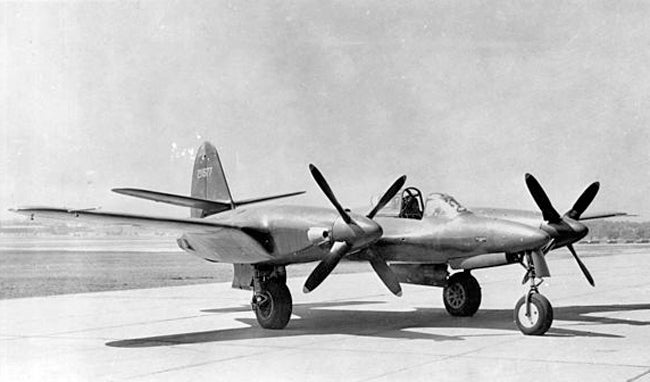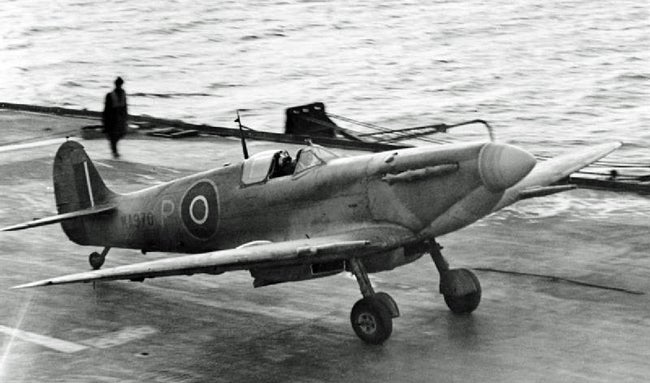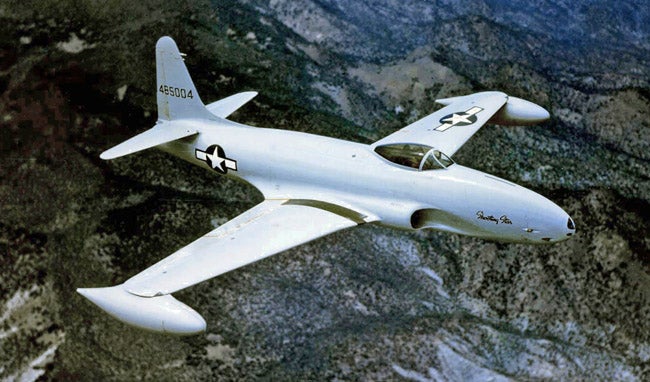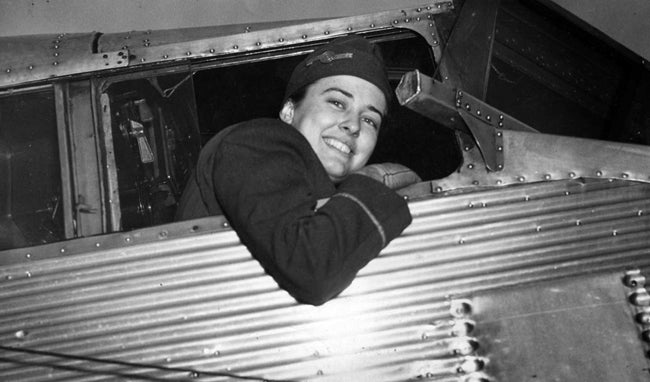 "ttyymmnn" (ttyymmnn)
"ttyymmnn" (ttyymmnn)
01/08/2016 at 12:35 • Filed to: planelopnik, planelopnik history
 14
14
 6
6
 "ttyymmnn" (ttyymmnn)
"ttyymmnn" (ttyymmnn)
01/08/2016 at 12:35 • Filed to: planelopnik, planelopnik history |  14 14
|  6 6 |
Welcome to This Date in Aviation History , getting you caught up on milestones and important historical events in aviation from January 6 through January 8.
!!! UNKNOWN CONTENT TYPE !!!

January 6, 1944 – The first flight of the McDonnell XP-67.
McDonnell, and later McDonnel Douglas, has become a storied name in American military and civilian aviation, but the company that eventually built some of the most iconic American military and civilian aircraft actually began as an aircraft parts supplier. Their first foray into aircraft design was the ill-fated XP-67, an attempt to build a high-speed, high-altitude interceptor for the Army that would be used to shoot down high-flying enemy bombers. At a time when the Army feared that American aircraft design had become stagnant, they issued Request for Proposal R-40C, hoping that designers would make an effort to create more advanced, even radical airplanes that would push the boundaries of standard aircraft development. McDonnell was one of twenty-three companies that responded to the request, and while their complex, single-engine, gear-driven aircraft fell into 21st place, the Army was impressed with McDonnell’s design, which they called Model I, and awarded the fledgling company $3000 to continue development of the aircraft. McDonnell responded with Model II, and then Model IIa, which was a more traditional twin-engine design, but it was the shape of the new aircraft that was revolutionary. The unique design, which was dubbed “The Bat,” was an attempt by McDonnell to continue the airfoil design throughout the fuselage, with extended fairings that blended the wing, engines and fuselage into a single structure. By employing a
!!!error: Indecipherable SUB-paragraph formatting!!!
wing design, McDonnell promised a top speed of 472 mph with a gross weight of 18,600 pounds, although the weight soon ballooned to 20,000 pounds. Still, the Army awarded McDonnell $1.5 million to build two prototypes and test the radical interceptor. Building a laminar flow wing in the way McDonnell proposed proved troublesome, as the aircraft’s skin needed to be perfectly smooth, and new production processes had to be developed to construct the aircraft. Engine cooling also proved problematic, and the issue was never fully resolved. The engines, a pair of
!!!error: Indecipherable SUB-paragraph formatting!!!
inverted, liquid-cooled V-12s, like so many engines of that era, proved underpowered. Flight tests showed that the new fighter flew reasonably well, but its climb rate was unacceptable, and it never reached the top speeds promised. An engine fire during a test flight in 1944 destroyed the single flying prototype, and since the XP-67 showed no real advances in performance over existing designs, the project was canceled. Undeterred, McDonnell would follow the XP-67 with the
!!!error: Indecipherable SUB-paragraph formatting!!!
, the first fully jet-powered aircraft to operate from an aircraft carrier, as well as numerous other highly successful jet fighters.
(US Air Force photo)
!!! UNKNOWN CONTENT TYPE !!!

January 7, 1942 – The first flight of the Supermarine Seafire.
As England entered WWII, they faced a serious need for a modern, high-performance fighter to operate from their aircraft carriers. As early as 1938, the government considered adapting the
!!!error: Indecipherable SUB-paragraph formatting!!!
for carrier operations, but that idea was initially dropped in favor of the production of the
!!!error: Indecipherable SUB-paragraph formatting!!!
, which provided a rugged, long-range airframe suitable for carrier use, but lacked the agility to dogfight with more modern German aircraft. As a result, the Fleet Air Arm (FAA) ended up starting the war with two woefully obsolete fighters, the
!!!error: Indecipherable SUB-paragraph formatting!!!
biplane and the
!!!error: Indecipherable SUB-paragraph formatting!!!
. To help cover the gap, the British purchased the
!!!error: Indecipherable SUB-paragraph formatting!!!
, which was known as the Martlet in British service. Following the success of converting the
!!!error: Indecipherable SUB-paragraph formatting!!!
to naval service, the idea of converting the Spitfire was revisited, and existing Spits were modified with an A-frame arrestor hook and reinforced fuselage. However, its narrow undercarriage proved unsuited to landing on a moving deck, and the intake scoops under the wings made water ditchings particularly hazardous. The Royal Navy soon learned that the fuselage remained too weak for the rigors of carrier landings, so the aircraft was further strengthened. But it was still not a purpose-built naval fighter. Further refinements continued, but as development progressed, the Seafire became heavier and its performance suffered. Range, which was already relatively short, as the original Spitfire was designed as a land-based plane, also suffered. It wasn’t until the third variant that the Seafire finally received folding wings. During 1942 and 1943, the Seafire gradually replaced the Hurricane in service, first seeing service during
!!!error: Indecipherable SUB-paragraph formatting!!!
, the Allied invasion of North Africa. In the Pacific, the Seafire proved to be the match of the
!!!error: Indecipherable SUB-paragraph formatting!!!
(Zero), but still not as effective overall as contemporary American fighters that were designed as naval fighters from the beginning. Unlike many aircraft that were designed before WWII, the Seafire remained with the Royal Navy after the end of the war, but was given a more powerful Griffon engine in place of the Merlin. This gave the fighter a significant boost in performance, but a new, more serious problem arose. Unlike the Merlin, the Griffin engine swing to the left, and even with full rudder correction on takeoff, the Seafire would move towards, rather than away from, the carrier’s island. This was eventually rectified in the definitive Mk 47 variant, which was fitted with a contra-rotating propeller. Mk 47 Seafires saw service in the Korean War in 1950, but by 1951, all Seafires had been removed from front line service. In all its variants, over 2,300 Seafires were produced.
(UK Government photo)
!!! UNKNOWN CONTENT TYPE !!!

January 8, 1944 – The first flight of the Lockheed P-80 Shooting Star.
Arguably the most important aviation technology to come from WWII was the jet engine. And while the Germans were first to field a jet-powered fighter with the
!!!error: Indecipherable SUB-paragraph formatting!!!
, the British were close on their heels with the
!!!error: Indecipherable SUB-paragraph formatting!!!
. The Americans, however, were much farther behind on jet engine development, so their first efforts in the jet fighter age would be powered by British engines. Nevertheless, the P-80 Shooting Star would emerge as perhaps the best jet fighter of the war period, though it came too late to see combat in that conflict. The Shooting Star began as a development of the
!!!error: Indecipherable SUB-paragraph formatting!!!
, America’s first jet-powered fighter, when Bell was unable to continue its development and the design passed to Lockheed. In just 143 days, Lockheed had designed the new fighter and built it around a
!!!error: Indecipherable SUB-paragraph formatting!!!
turbojet engine. While that engine only provided 2,460 pounds of thrust, the Shooting Star still reached a top speed of 502 mph, the first American aircraft to exceed 500 mph in level flight. Later variants would be powered by a General Electric I-40 engine, itself an improvement of another British design, and ultimately produced by Allison as the
!!!error: Indecipherable SUB-paragraph formatting!!!
. The Air Force was so impressed with the performance of the sleek new fighter that they immediately ordered 5,000 copies, but that number was reduced to 917 with the end of WWII. The early Shooting Stars were not without teething troubles, and difficulties with fuel pumps led to a spate of crashes, one of which killed America’s top scoring WWII fighter ace
!!!error: Indecipherable SUB-paragraph formatting!!!
. But once the fuel delivery issues were solved, the P-80, now called the F-80 in the revised Air Force designation system, went on to become an excellent fighter, and the Shooting Star laid claim to the world’s first jet-to-jet aerial victory when it downed a Russian-built
!!!error: Indecipherable SUB-paragraph formatting!!!
in the skies over Korea. Still, the Shooting Star was no match for the swept-wig MiG, so air superiority duties were turned over to the
!!!error: Indecipherable SUB-paragraph formatting!!!
, while the F-80 took on ground attack and reconnaissance missions. But while the Shooting Star was soon outclassed as a fighter, it would become legendary as America’s first jet trainer, the
!!!error: Indecipherable SUB-paragraph formatting!!!
. Nearly four times as many T-33s were built (6,557), and the trainer would serve into the 1980s, with some still flying today.
(US Air Force photo)
!!! UNKNOWN CONTENT TYPE !!!
Short Take Off
!!! UNKNOWN CONTENT TYPE !!!

January 7, 1960 – The first launch of the Polaris missile.
The United States, along with Russia, utilize what is known as the
!!!error: Indecipherable SUB-paragraph formatting!!!
, which is the ability to attack their enemies with nuclear weapons from three sources: aircraft, land-based intercontinental ballistic missiles (ICBM), or submarines. The US was the first to drop an atomic bomb from an airplane during WWII, and they followed that with the
!!!error: Indecipherable SUB-paragraph formatting!!!
land-based ICBM in October of 1959. To complete the triad, the Polaris, a two-stage, solid fuel rocket that could be launched from a submerged submarine, entered service in 1961. The
!!!error: Indecipherable SUB-paragraph formatting!!!
!!!error: Indecipherable SUB-paragraph formatting!!!
(SSBN-598) became the first ballistic missile submarine and carried sixteen Polaris A-1 missiles. Forty more SSBNs were launched from 1960-1966.
(US Navy photo)
!!! UNKNOWN CONTENT TYPE !!!

January 7, 1947 – The death of Helen Richey.
Born in 1909, Richey was a pioneering aviatrix and the first woman to be hired as a commercial airline pilot in the US. Richey obtained her pilot’s license at age 20, and in 1933, with the help of pilot Frances Marsalis, she set an endurance record by staying aloft for 10 days with midair refueling. She also competed in air races, toured with
!!!error: Indecipherable SUB-paragraph formatting!!!
, and set an altitude record of over 18,000 feet. In 1934, Richey was hired by Central Airlines of Pennsylvania, where she flew a
!!!error: Indecipherable SUB-paragraph formatting!!!
, though she was eventually forced to quit her job by the all-male pilot’s union. Richey was also the first woman to be certified as an airmail pilot, and one of the first women to serve as a flight instructor. She died in 1947 of an apparent overdose, and her death was ruled a suicide.
(Photo via the
!!!error: Indecipherable SUB-paragraph formatting!!!
)
!!! UNKNOWN CONTENT TYPE !!!

January 8, 1959 – The first flight of the Armstrong Whitworth AW.650/660 Argosy, a post-war, medium transport developed for the RAF and the final aircraft produced by !!!error: Indecipherable SUB-paragraph formatting!!! . Armstrong Whitworth was perhaps best known for the !!!error: Indecipherable SUB-paragraph formatting!!! bomber, which served as a large frontline bomber with the RAF throughout WWII. The Argosy arose from an RAF request for a freighter capable of carrying 25,000 pounds of cargo at a range of up to 2,000 miles. However, the RAF was initially uninterested in Armstrong Whitworth’s design, so the company forged ahead on their own with a civilian version, the AW.650, eventually developing the AW.660 militarized version when the RAF needed to replace their obsolete WWII-era freighters. A total of 74 Argosys were produced. (Photo by RuthAS via !!!error: Indecipherable SUB-paragraph formatting!!! )
!!! UNKNOWN CONTENT TYPE !!!
!!! UNKNOWN HEADER TYPE (MULTI-LINE BREAK?) !!!
!!! UNKNOWN CONTENT TYPE !!!
!!! UNKNOWN CONTENT TYPE !!!
!!! UNKNOWN CONTENT TYPE !!!
!!! UNKNOWN CONTENT TYPE !!!
If you enjoy these Aviation History posts, please let me know in the comments. And if you missed any of the past articles, you can find them all at
!!!error: Indecipherable SUB-paragraph formatting!!!
.
!!! UNKNOWN CONTENT TYPE !!!
 BringBackTheCommodore
> ttyymmnn
BringBackTheCommodore
> ttyymmnn
01/08/2016 at 12:56 |
|
Yet another fantastic post!
Helen Richey’s spirit lives on today, in the women that strike out into aviation.
 The Powershift in Steve's '12 Ford Focus killed it's TCM (under warranty!)
> ttyymmnn
The Powershift in Steve's '12 Ford Focus killed it's TCM (under warranty!)
> ttyymmnn
01/08/2016 at 13:42 |
|
Excellent post as always!. I look forward to these every few days.
 ttyymmnn
> The Powershift in Steve's '12 Ford Focus killed it's TCM (under warranty!)
ttyymmnn
> The Powershift in Steve's '12 Ford Focus killed it's TCM (under warranty!)
01/08/2016 at 14:01 |
|
Thank you, sir!
 ttyymmnn
> BringBackTheCommodore
ttyymmnn
> BringBackTheCommodore
01/08/2016 at 14:03 |
|
Thank you, sir!
I always like to highlight the accomplishments of women aviators, since they were (and remain, to some extent) so under-represented in the profession. Another aviatrix will be featured in the next post. Tune in Tuesday!
 gmporschenut also a fan of hondas
> ttyymmnn
gmporschenut also a fan of hondas
> ttyymmnn
01/09/2016 at 00:42 |
|
Whoa its as if a Tigercat and Norton flying wing had an offspring.
8 20mm? Somebody would of had a bad day.
 ttyymmnn
> gmporschenut also a fan of hondas
ttyymmnn
> gmporschenut also a fan of hondas
01/09/2016 at 09:11 |
|
It was designed to shoot down bombers, so they weren’t messing around.